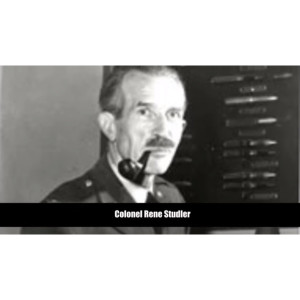
Studler
Col. Studler, who had lived in Washington since 1940, was born in Blutton, Ohio. He earned a bachelor's degree at Ohio State University and a master's degree in engineering from the Massachusetts Institute of Technology.
He was born 10 February 1895 in Bluffton, Ohio, graduated from Ohio State University in 1917. He joined the Army and earned his pilot's wings, and from 1918 to 1919 served as Flying Instructor at the Air Service Flying School in Texas and then Oklahoma. From 1919 to 1921 he was Operations Officer and then Commander of the 258th Heavy Bombardment Squadron, later redesignated Flight B, 14th Squadron (Bombardment), stationed at Aberdeen Proving Ground (APG), Maryland. Studler's squadron was heavily involved in the testing of aircraft ordnance.
Intrigued with the work of developing weapons, Studler transferred from the Air Service to the Ordnance Department in 1922. After completing the two-year Ordnance School of Application at Watertown Arsenal, which included studies at the Massachusetts Institute of Technology, he reported to the Office of the Chief of Ordnance (OCO) in Washington, DC, to serve as Assistant Small Arms Officer in the Small Arms Division. He worked as a troubleshooter, making repeated trips to APG, Frankford Arsenal in Philadelphia, Springfield Armory in Massachusetts, and civilian industries to consult on development and production issues or to advise on maintenance procedures.
Studler next served, from 1928 to 1929, as Proof Officer in the Gun Testing Division at APG, where he continued his work in developing and testing small arms. From 1929 to 1931 he was stationed in the Philippines as Commander of the 75th Ordnance Company and then as Adjutant, Executive Officer, and finally Commander of the Philippine Ordnance Depot. Returning to the United States, he served as Assistant Officer in Charge, then Officer in Charge, of the Engineering Division of the Small Arms Ammunition Department at Frankford Arsenal. He was commended for his development of armor- piercing .30 and .50 caliber ammunition.
In 1935, Studler returned to OCO to serve again as Assistant Small Arms Officer in the Small Arms Division. While there he applied for a three-month leave of absence to visit European small arms and small-arms ammunition manufacturing facilities. His resulting report so impressed his superiors that Studler was assigned in 1936 as Assistant Military Attaché at the US Embassy in London to continue his reporting. Proficient in five European languages, Studler had carte blanche to roam throughout Europe gathering technical intelligence. Visiting factories and military facilities, he filed 373 reports on everything from small arms to tanks to aircraft.
As important as Studler's work in technical intelligence was his expertise in small arms was even more in demand, and in 1940 he was recalled from Europe to again serve in the Small Arms Division in the Office of the Chief of Ordnance, this time as Chief. He held this position for the next 13 years, playing a vital role in developing ground and aircraft-mounted weapons and accessories, to include the M-1 helmet, .30 and .50 caliber armor-piercing incendiary ammunition, the M3 aircraft machine gun, the M3 submachine gun, the M1 and M2 carbines, the 2.36 inch and 3.5 inch rocket launchers, and the 57mm, 75mm, and 105mm recoilless rifles. Studler retired in 1953 after 36 years of distinguished service.
Consultant
City, US
Work Experience
Office of the Chief of Ordnance, Assistant Small Arms Officer, Apr 1973 ~ Oct 1977
After completing the two-year Ordnance School of Application at Watertown Arsenal, which included studies at the Massachusetts Institute of Technology, he reported to the Office of the Chief of Ordnance (OCO) in Washington, DC, to serve as Assistant Small Arms Officer in the Small Arms Division. He worked as a troubleshooter, making repeated trips to APG, Frankford Arsenal in Philadelphia, Springfield Armory in Massachusetts, and civilian industries to consult on development and production issues or to advise on maintenance procedures.
Air Service Flying School, Flying Instructor, Sep 1962 ~ Nov 1967
After Studler joined the Army and earned his pilot's wings, for one year he served as Flying Instructor at the Air Service Flying School in Texas and then Oklahoma.
Education
Ohio State University, Bachelor of Engineering (BEng), 1961 ~ 1966
Studler graduated from Ohio State University.
